If you were asked to name three key components of Microsoft Excel, what would they be? Most likely, spreadsheets to input data, formulas to perform calculations and charts to create graphical representations of various data types.
I believe, every Excel user knows what a chart is and how to create it. However, one graph type remains opaque to many - the Gantt chart. This short tutorial will explain the key features of the Gantt diagram, show how to make a simple Gantt chart in Excel, where to download advanced Gantt chart templates and how to use the online Project Management Gantt Chart creator.
What is a Gantt chart?
The Gantt chart bears a name of Henry Gantt, American mechanical engineer and management consultant who invented this chart as early as in 1910s. A Gantt diagram in Excel represents projects or tasks in the form of cascading horizontal bar charts. A Gantt chart illustrates the breakdown structure of the project by showing the start and finish dates as well as various relationships between project activities, and in this way helps you track the tasks against their scheduled time or predefined milestones.

How to make Gantt chart in Excel
Regrettably, Microsoft Excel does not have a built-in Gantt chart template as an option. However, you can quickly create a Gantt chart in Excel by using the bar graph functionality and a bit of formatting.
Please follow the below steps closely and you will make a simple Gantt chart in under 3 minutes. We will be using Excel 2010 for this Gantt chart example, but you can simulate Gantt diagrams in any version of Excel 2013 through Excel 365 in the same way.
1. Create a project table
You start by entering your project's data in an Excel spreadsheet. List each task is a separate row and structure your project plan by including the Start date, End date and Duration, i.e. the number of days required to complete the tasks.
Tip. Only the Start date and Duration columns are necessary for creating an Excel Gantt chart. If you have Start Dates and End Dates, you can use one of these simple formulas to calculate Duration, whichever makes more sense for you:
Duration = End Date - Start Date
Duration = End date - Start date + 1
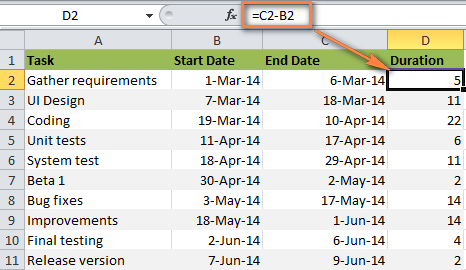
2. Make a standard Excel Bar chart based on Start date
You begin making your Gantt chart in Excel by setting up a usual Stacked Bar chart.
- Select a range of your Start Dates with the column header, it's B1:B11 in our case. Be sure to select only the cells with data, and not the entire column.
- Switch to the Insert tab > Charts group and click Bar.
- Under the 2-D Bar section, click Stacked Bar.

As a result, you will have the following Stacked bar added to your worksheet:
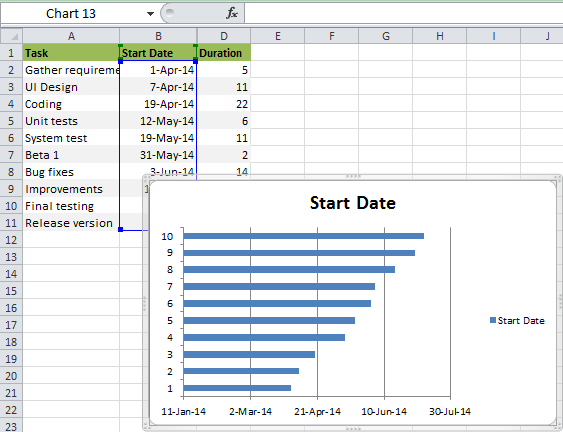
Note. Some other Gantt Chart tutorials you can find on the web recommend creating an empty bar chart first and then populating it with data as explained in the next step. But I think the above approach is better because Microsoft Excel will add one data series to the chart automatically, and in this way save you some time.
3. Add Duration data to the chart
Now you need to add one more series to your Excel Gantt chart-to-be.
- Right-click anywhere within the chart area and choose Select Data from the context menu.
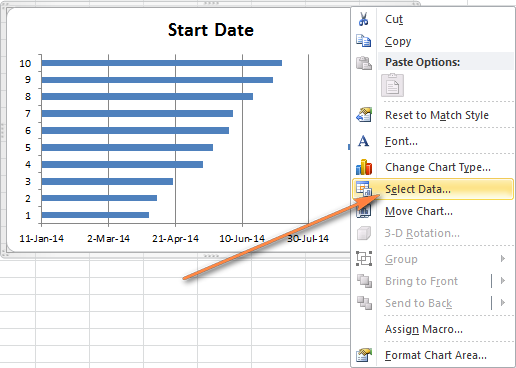 The Select Data Source window will open. As you can see in the screenshot below, Start Date is already added under Legend Entries (Series). And you need to add Duration there as well.
The Select Data Source window will open. As you can see in the screenshot below, Start Date is already added under Legend Entries (Series). And you need to add Duration there as well. - Click the Add button to select more data (Duration) you want to plot in the Gantt chart.
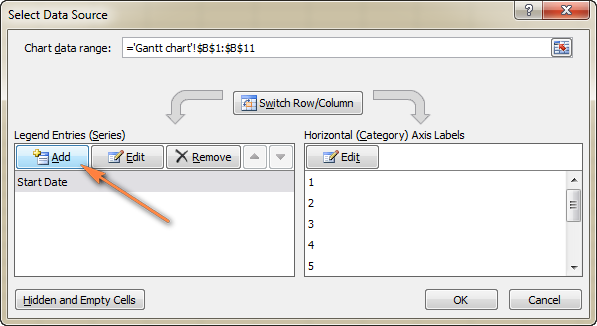
- The Edit Series window opens and you do the following:
- In the Series name field, type "Duration" or any other name of your choosing. Alternatively, you can place the mouse cursor into this field and click the column header in your spreadsheet, the clicked header will be added as the Series name for the Gantt chart.
- Click the range selection icon
 next to the Series Values field.
next to the Series Values field.

- A small Edit Series window will open. Select your project Duration data by clicking on the first Duration cell (D2 in our case) and dragging the mouse down to the last duration (D11). Make sure you have not mistakenly included the header or any empty cell.
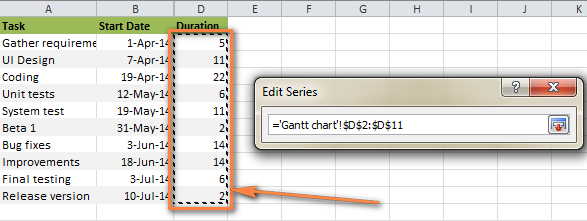
- Click the Collapse Dialog icon to exit this small window. This will bring you back to the previous Edit Series window with Series name and Series values filled in, where you click OK.
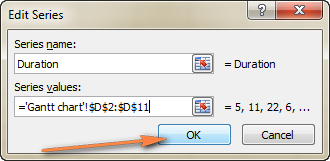
- Now you are back at the Select Data Source window with both Start Date and Duration added under Legend Entries (Series). Simply click OK for the Duration data to be added to your Excel chart.
 The resulting bar chart should look similar to this:
The resulting bar chart should look similar to this:
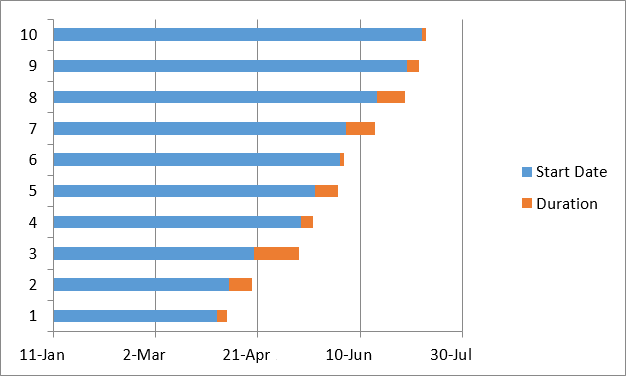
4. Add task descriptions to the Gantt chart
Now you need to replace the days on the left side of the chart with the list of tasks.
- Right-click anywhere within the chart plot area (the area with blue and orange bars) and click Select Data to bring up the Select Data Source window again.
- Make sure the Start Date is selected on the left pane and click the Edit button on the right pane, under Horizontal (Category) Axis Labels.

- A small Axis Label window opens and you select your tasks in the same fashion as you selected Durations in the previous step - click the range selection icon
 , then click on the first task in your table and drag the mouse down to the last task. Remember, the column header should not be included. When done, exit the window by clicking on the range selection icon again.
, then click on the first task in your table and drag the mouse down to the last task. Remember, the column header should not be included. When done, exit the window by clicking on the range selection icon again.

- Click OK twice to close the open windows.
- Remove the chart labels block by right-clicking it and selecting Delete from the context menu.
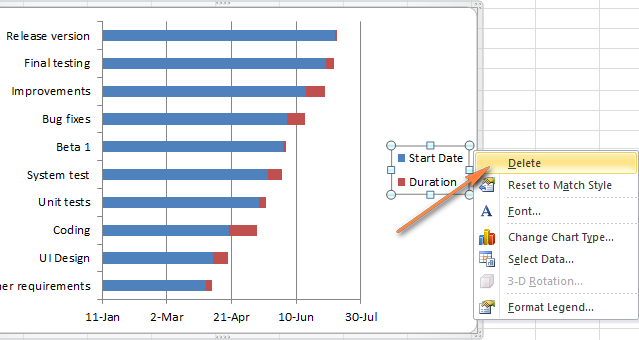 At this point your Gantt chart should have task descriptions on the left side and look something like this:
At this point your Gantt chart should have task descriptions on the left side and look something like this:
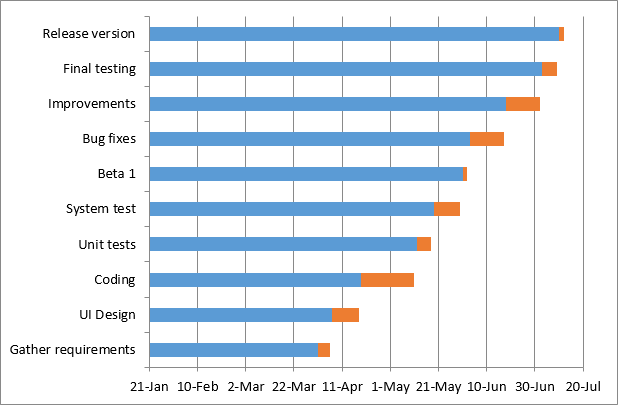
5. Transform the bar graph into the Excel Gantt chart
What you have now is still a stacked bar chart. You have to add the proper formatting to make it look more like a Gantt chart. Our goal is to remove the blue bars so that only the orange parts representing the project's tasks will be visible. In technical terms, we won't really delete the blue bars, but rather make them transparent and therefore invisible.
- Click on any blue bar in your Gantt chart to select them all, right-click and choose Format Data Series from the context menu.
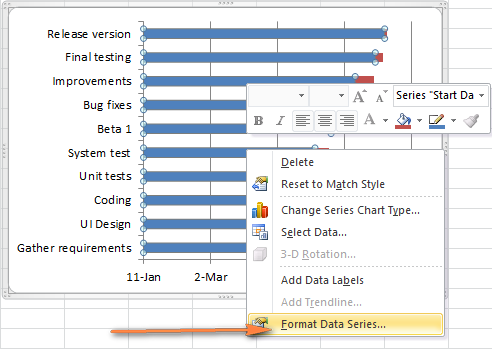
- The Format Data Series window will show up and you do the following:
- Switch to the Fill tab and select No Fill.
- Go to the Border Color tab and select No Line.

Note. You do not need to close the dialog because you will use it again in the next step.
- As you have probably noticed, the tasks on your Excel Gantt chart are listed in reverse order. And now we are going to fix this.Click on the list of tasks in the left-hand part of your Gantt chart to select them. This will display the Format Axis dialog for you. Select the Categories in reverse order option under Axis Options and then click the Close button to save all the changes.
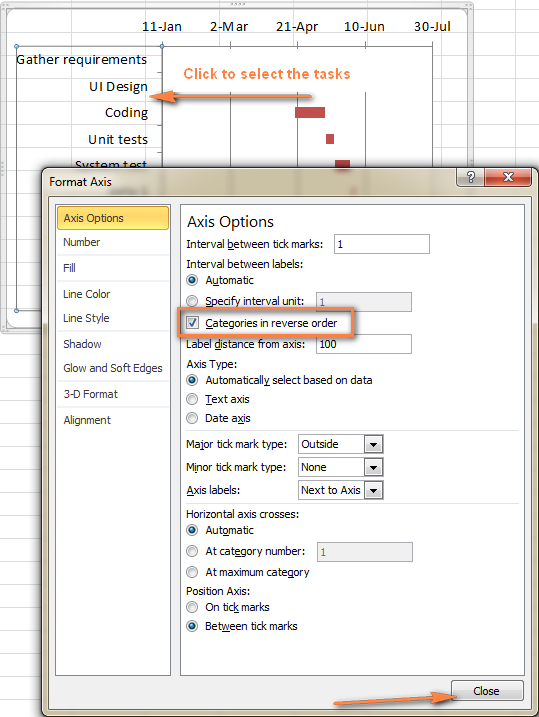
The results of the changes you have just made are:
- Your tasks are arranged in a proper order on a Gantt chart.
- Date markers are moved from the bottom to the top of the graph.
Your Excel chart is starting to look like a normal Gantt chart, isn't it? For example, my Gantt diagram looks like this now:

6. Improve the design of your Excel Gantt chart
Though your Excel Gantt chart is beginning to take shape, you can add a few more finishing touches to make it really stylish.
- Remove the empty space on the left side of the Gantt chart.As you remember, originally the starting date blue bars resided at the start of your Excel Gantt diagram. Now you can remove that blank white space to bring your tasks a little closer to the left vertical axis.
- Right-click on the first Start Date in your data table, select Format Cells > General. Write down the number that you see - this is a numeric representation of the date, in my case 41730. As you probably know, Excel stores dates as numbers based on the number of days since 1-Jan-1900. Click Cancel because you don't actually want to make any changes here.
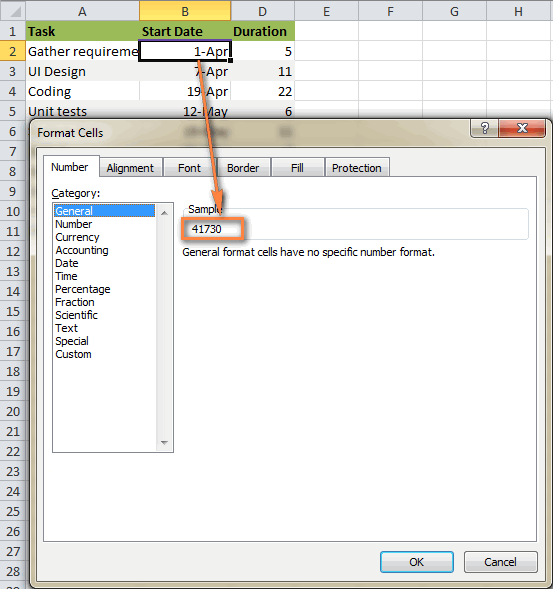
- Click on any date above the task bars in your Gantt chart. One click will select all the dates, you right click them and choose Format Axis from the context menu.
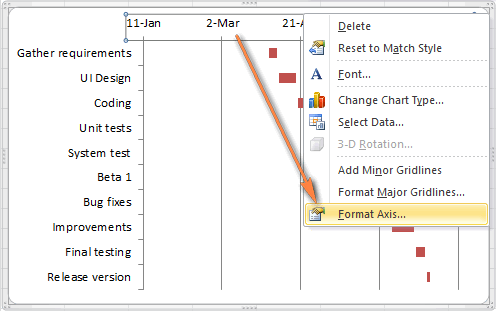
- Under Axis Options, change Minimum to Fixed and type the number you recorded in the previous step.
- Right-click on the first Start Date in your data table, select Format Cells > General. Write down the number that you see - this is a numeric representation of the date, in my case 41730. As you probably know, Excel stores dates as numbers based on the number of days since 1-Jan-1900. Click Cancel because you don't actually want to make any changes here.
- Adjust the number of dates on your Gantt chart. In the same Format Axis window that you used in the previous step, change Major unit and Minor unit to Fixed too, and then add the numbers you want for the date intervals. Typically, the shorter your project's timeframe is, the smaller numbers you use. For example, if you want to show every other date, enter 2 in the Major unit. You can see my settings in the screenshot below.
Note. In Excel 365, Excel 2021 - 2013, there are no Auto and Fixed radio buttons, so you simply type the number in the box.

Tip. You can play with different settings until you get the result that works best for you. Don't be afraid to do something wrong because you can always revert to the default settings by switching back to Auto in Excel 2010 and 2007, or click Reset in Excel 2013 and later.
- Remove excess white space between the bars. Compacting the task bars will make your Gantt graph look even better.
- Click any of the orange bars to get them all selected, right click and select Format Data Series.
- In the Format Data Series dialog, set Separated to 100% and Gap Width to 0% (or close to 0%).

And here is the result of our efforts - a simple but nice-looking Excel Gantt chart:
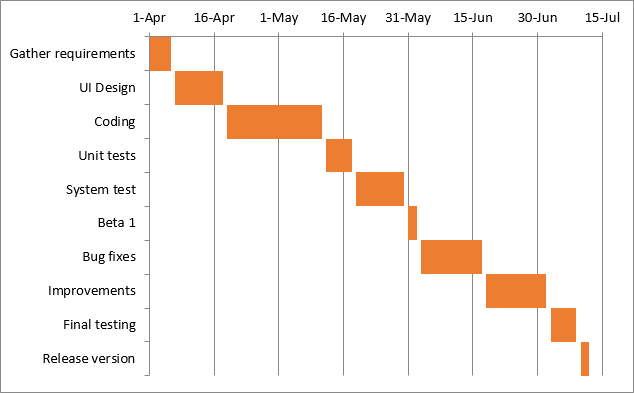
Remember, though your Excel chart simulates a Gantt diagram very closely, it still keeps the main features of a standard Excel chart:
- Your Excel Gantt chart will resize when you add or remove tasks.
- You can change a Start date or Duration, the chart will reflect the changes and adjust automatically.
- You can save your Excel Gantt chart as an image or convert to HTML and publish online.
Tips:
- You can design your Excel Gant chart in different ways by changing the fill color, border color, shadow and even applying the 3-D format. All these options are available in the Format Data Series window (right-click the bars in the chart area and select Format Data Series from the context menu).

- When you have created an awesome design, it might be a good idea to save your Excel Gantt chart as a template for future use. To do this, click the chart, switch to the Design tab on the ribbon and click Save as Template.
Excel Gantt chart templates
As you see, it's not a big problem to build a simple Gantt chart in Excel. But what if you want a more sophisticated Gantt diagram with percent-complete shading for each task and a vertical Milestone or Checkpoint line? Of course, if you are one of those rare and mysterious creatures whom we respectively call "Excel gurus", you can try to make such a graph on your own, with the help of this article: Advanced Gantt Charts in Microsoft Excel.
However, a faster and more stress-free way would be using an Excel Gantt chart template. Below you will find a quick overview of several project management Gantt chart templates for different versions of Microsoft Excel.
Gantt chart template for Microsoft Excel
This Excel Gantt chart template, called Gantt Project Planner, is purposed to track your project by different activities such as Plan Start and Actual Start, Plan Duration and Actual Duration as well as Percent Complete.
In Excel 2013 - 2021, just go to File > New and type "Gantt" in the Search box. If you cannot find it there, you can download it from Microsoft's web-site - Gantt Project Planner template. This template requires no learning curve at all, simply click on it and it's ready for use.
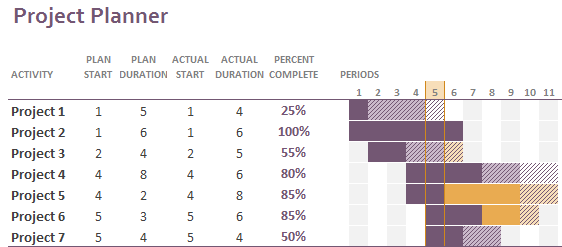
Online Gantt chart template
This is an Interactive Online Gantt Chart Creator from smartsheet.com. As well as the previous Gantt chart template, this one is fast and easy-to-use. They offer 30 days free trial, so you can sign with your Google account here and start making your first Excel Gantt diagram online straight away.
The process is very straightforward, you enter your project details in the left-hand table, and as you type a Gantt Chart is being built in the right-hand part of the screen.
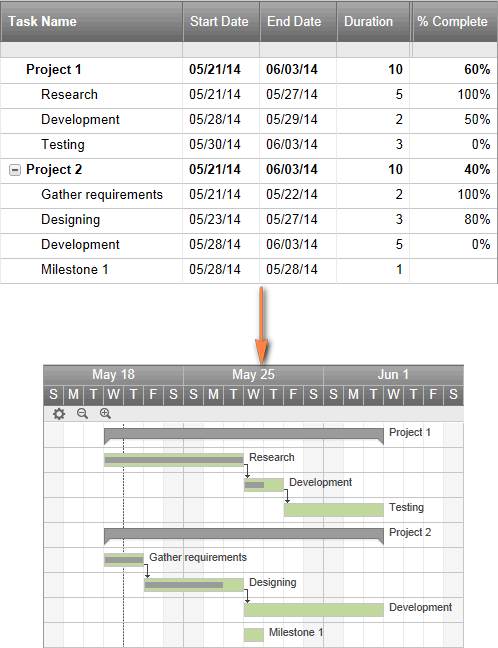
Gantt chart template for Excel, Google Sheets and OpenOffice Calc
Gantt chart template from vertex42.com is a free Gantt chart template that works with Excel as well as OpenOffice Calc and Google Sheets. You work with this template in the same fashion as you do with any normal Excel spreadsheet. Simply enter the start date and duration for each task and define % in the Complete column. To change the range of dates displayed in the Gantt chart area, slide the scroll bar.
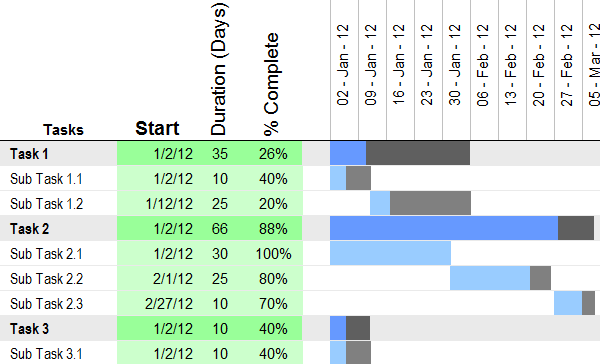
And finally, one more Gant chart Excel template for your consideration.
Project Manager Gantt Chart template
Project Manager Gantt Chart from professionalexcel.com is also a free project management Gantt chart template for Excel that can help track your tasks against their allocated time. You can choose either the standard weekly view or daily for short term projects.
Hopefully, at least one of the above-mentioned templates is suited for your needs. If not, you can create your own Gantt chart as demonstrated in the first part of this tutorial, and then save it as an Excel template.
Now that you are familiar with the main features of the Gantt diagram, you can explore it further and create your own sophisticated Gantt charts in Excel to amaze your boss and co-workers : )
Practice workbook for download
Gantt chart example (.xlsx file)
 by
by
426 comments
Thank you for the excellent step-by-step instructions with example screen shots.
With your instructions I was able to create a Gantt chart in my existing spreadsheet that provides an nice visual to target dates.
Hi. what if you have several tasks to do in one day? how will you reflect that in your gantt chart in such a way that the time for each task follows each other without spilling into other days?
Hi there
I'm in the process of making a GANTT for a project I'm working on which has specific dates for events/meetings etc alongside tasks which may take between 1 week and 2 months to complete. Is there a way to incorporate these into a GANNT in addition to blocks of time?
Svetlana,
I cannot thank you enough for the Excel Gantt chart process and tips you provided. It certainly saved me a great deal of time tonight and my presentation is now ready to go! Your efforts are truly appreciated! Thank you very much.
Regards,
Lynn
Thanks...very useful...
this tutorial is great and setting up from scratch works way better than most available templates due to formatting.
great explanation step by step in detail... thank you team.
Let great thanks be posed to the developer and publisher of the tutorial. It has been extravagant helpful and self explanatory thus eases quick understanding.
Thanks a lot
Hi,
This has been one of the best instructions I've found on the net for anything I needed. I needed to make a gantt chart quickly (in half an hour) and thanks to the instructions given here, I've succeeded.
Thank you!
I used your technique and have time on the horizontal axis, date on the vertical and am plotting duration. Is there a way to color code my bars according to the task they were doing for each specific duration of time?
This is very helpful. but i need to also actual duration to be reflected on it. so that i can monitor through graph whether i am on or behind the schedule
SvetlanaChka;
Ochin Harasho, otlichno, Spazibo
How to adjust the time line to Hours & Minutes scale instead of Days?
This is needed for monitoring small projects with a number of tasks that run through 1 or 2 days.
Thank you for your tutorial. this is extremely helpful. Does anyone know how to add the end date as the label of the bar?
Hi @Svetlana Cheusheva - you are amazing thank you.
Btw, I followed all your instructions and I am happy to say that i was been able to successfully replicate it. However, whenever I add a new task - it seems that the its not added in the chart and the formula for duration is not following :(
I tried to drag hoping it will copy the formula but kinda weird that it is not copying.
Please anyone help.
Thank you
How to swap task,either above or below one the other?
your response will be highly appreciated.
Thank you.
lol there is a gantt chart template anyway now
Thank you so much Svetlana,
the explanation & its way is so good. I really learnt & I was so happy when the Gantt was building up in parallel to your steps.
My only problem was that the date format was in numbers, I tried to format it to desired date format, it is not working hence the chart shows huge numbers, nevertheless, I will try again to fix it. Hopefully I can do it.
thanks a ton for this knowledge
Wish you Svetlana
Very helpful,thank you very much.
Very easy and useful.
I was wondering if it is possible to add vacancy breaks in the chart.
I want to design it so that the tasks that will occur during the vacancies are delayed after the break.Is it possible? Any help appreciated!!
Very helpful, thank you very much for sharing step by step instructions.
I got all the way through the tutorial with no issue until Step 6. What I see now is extra dates to the left of my actual start dates for the project. In other words, I have dates in the top axis that I cannot remove and start before the project actually starts. Any help is appreciated!!
Hi Alayna,
Please see Step 6. Improve the design of your Excel Gantt chart. It explains how to remove extra dates in the left part.
Thank you! Best instructions I could find. Thank you.
Really helpful tutorial! Thanks!!
thank you so much for this post, you help me alot, but why my horizontal axis cant be name like your's..
pls tell me what is wrong with my table.
Thanks in advance.
i was able to figure it out..
thankss again..
Hello, I just wanted to express my thanks to you so much for the thorough walk through. Keep up the good work!
Really useful and intuitive tool
Thanks! wayne
good and excellent one for begineers
Thank you for an easy and effective tutorial.
Thank you So much for sharing :)
Up until today never designed a Gannt Chart , the tutorial was very good easy to follow once i got over the Excel glitches and worked my way through it, once I had created the chart and adjusted all the looks it looked impressive from my point of view, Have sent it in for my Diploma assessment, thanks for the good tutorial
Curious to know is there an easy way to add an additional line to the chart without redesigning it all
This worked very well for my needs. Thanks for making me look like a rock star.
Is there a way I can set different colours based on the contents of another column, like a conditional format / category.
Did you manage to find an answer to this question? This is exactly the same as what I need
Thank you! This was a life saver!
Hi again,
I was able to figure it out. Great, great tutorial,
Thank you very much.
Hi, I was able to get the start dates on my chart, but when I tried to get the duration, I got the message that my data range is too complex, but it really isn't. I have, for example duration of 7, 22, 27 days. When I open the select data box and try to do the duration, it will not highlight it. I cannot figure out what I am doing wrong.
Thanks, the article was really helpful.
Loved this! Had to create a Gantt chart for my studies and didn't have a clue where to start - thank you so much! :D
Great and helpful work. Thanks
Thank you so much
I have no idea how I got here!!!!! BUT YOU ARE AMAAAAAAAAZING!!!!!!!!!
I cannot get rid of vertical axis(bottom) showing as percentages instead of my selected data (dates) when I first select the bar graph. I have unlocked the protecton on the cells and reset it but it still shows the axis as percentages. Thanks
Thank you so much for this tutorial. It was very easy to use and I've managed to make my Gannt chart to plan out my dissertation for university!
was really helpful
Hello everyone,
Why this chart is starting from Jan 11? Here also the earliest activity start date is Mar 1, 2014. I followed the same steps and my first start date is Nov 27 but on my chart's date axis all activities are starting from Nov 11.
Please explain and tell me what I am doing wrong.
Thanks and Regards
Vabz
Hello Vabz,
Blue bars starting from Jan 11 were only an intermediate result. On step 5, we make them disappear so that only orange bars are visible (the earliest activity start date is Apr 1). To improve your Gantt chart further, please follow the instructions from step 6 that explain how to remove the empty space on the left side of the chart. The result is shown in the screenshot at the end of step 6 (the date axis beginning with Apr 1).
No words to thank you... simply thank you for sharing your knowledge. You people make this earth more beautiful. Thank You So Much.
Any templates for Ghatt chart
Awesome article! very helpful.
Great explanation, very useful feature, already rolled out to my team
thank you very much
Thank you so much this has been so helpful.